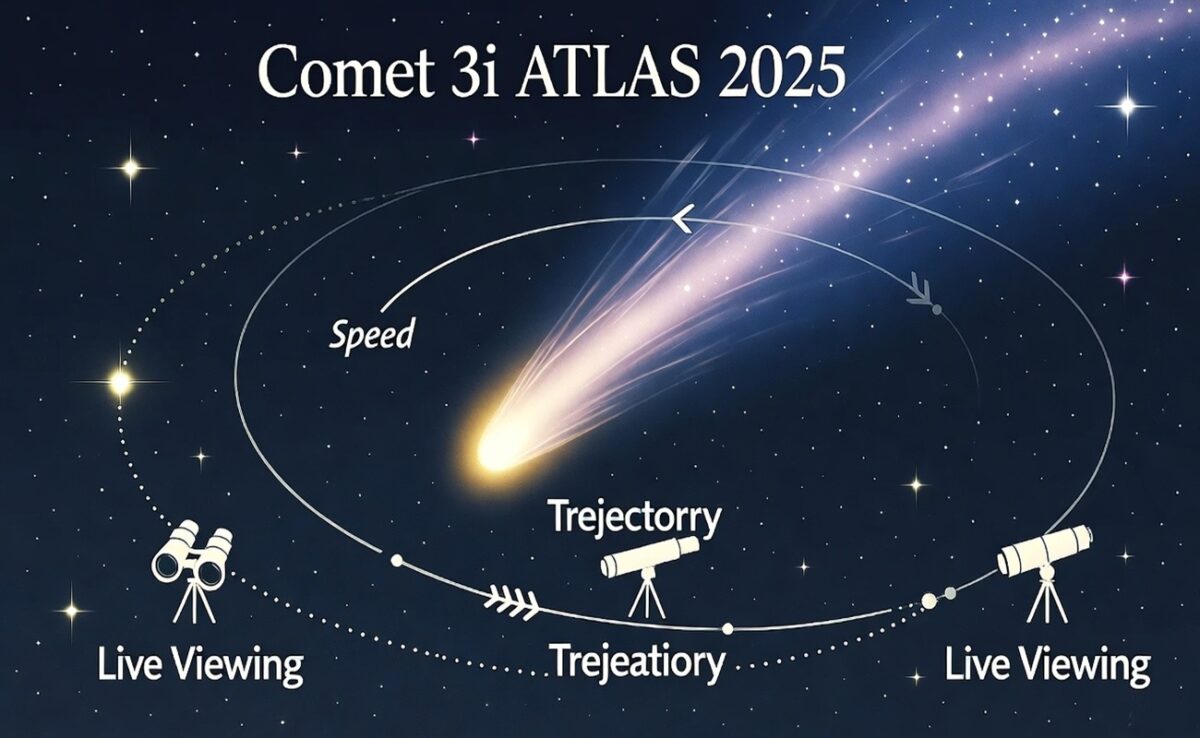Comet 3I ATLAS, a rare interstellar visitor, is threading a swift, hyperbolic path through the inner Solar System in late 2025 — and while it poses no danger to Earth, astronomers say its speed and brief visibility window make it a high-value target for observers and spacecraft. Recent measurements and mission updates show the object moving at tens of kilometers per second and skimming inside Mars’s orbit before reappearing for northern-hemisphere telescopes in December.
Current position, speed and trajectory
3I ATLAS follows a clearly hyperbolic trajectory, meaning it arrived from interstellar space and will depart the Solar System after its flyby. The object reached perihelion — its closest point to the Sun — around Oct. 29–30, 2025 at roughly 1.36–1.4 astronomical units (AU), inside Mars’s orbit. By mid-October and early November it passed near Mars and will remain well outside Earth’s orbit at closest approach, roughly 1.7–1.8 AU in December — comfortably distant and non-threatening.
Published speed estimates vary with measurement method and epoch. NASA’s tracking posts and early orbit solutions put 3I ATLAS at roughly 60 km/s in July–October observations, while some media summaries of mission telemetry report higher instantaneous speeds near perihelion — for example, press coverage noted speeds around 193,000 mph (≈86 km/s) during the Mars passage. Scientists caution that apparent speed differences reflect when and where the measurement was taken along the comet’s fast, curved path around the Sun.
Observability: when and where to watch it live
Ground-based visibility changed rapidly during the comet’s approach. Observers tracked 3I ATLAS with telescopes through mid-2025 as it brightened from very faint magnitudes (around 17–16) into the low teens — still beyond naked-eye range for most viewers. The object was effectively unobservable around perihelion while it passed behind the Sun from Earth’s vantage; NASA and space agencies note it should reappear to ground-based telescopes in early December as it moves away from solar conjunction.
For live tracking and finder charts, astronomy services such as TheSkyLive provide up-to-date star maps and ephemerides that show the comet’s location against constellations night-by-night. Several public observatories and streaming projects (including the Virtual Telescope Project and mission teams) planned live feeds around key dates when spacecraft or telescopes had clear views. Amateur astronomers with telescopes and CCD imaging gear will be best placed to capture the comet when it reemerges; binocular or naked-eye viewing is unlikely given predicted peak brightness near magnitude 11–12.
Scientific tracking: missions, telescopes and what they’re looking for
3I ATLAS attracted rapid international attention because it is only the third confirmed interstellar object on record. Spacecraft and observatories across agencies have been mobilized for opportunistic observations: Hubble provided resolved images that aided nucleus-size estimates, and several planetary missions — including orbiters around Mars and spacecraft in the inner Solar System — adjusted pointing or planned opportunistic measurements to capture high-quality data during close approaches. These observations aim to constrain the comet’s nucleus size, composition, outgassing behavior and any non-gravitational accelerations that could reveal unusual physical properties.
Researchers emphasize the scientific value of multi-wavelength coverage. Optical imaging outlines the coma and dust tail, while spectroscopy detects gas species (water, CN, CO) that indicate volatile content. Radio and infrared observations help estimate size and thermal properties. Combined, these datasets give a rapid, composite picture of an object that formed around another star and is now offering a one-time close look at interstellar material.
What amateur observers and the public should know
Practical viewing tips for those hoping to see or image 3I ATLAS:
- Check updated ephemerides — use TheSkyLive or NASA pages for nightly coordinates and predicted magnitude. Timing and position change quickly for fast movers.
- Use a telescope with tracking — at magnitude ~11–13 near best viewing, a small telescope with CCD or long-exposure capability will yield the best results; handheld binoculars will likely be insufficient.
- Watch mission livestreams — major observatories and the Virtual Telescope Project often stream high-resolution feeds when an object is favorably placed. These streams are the easiest way for the public to “see” the comet without specialist gear.
Scientists reiterate that 3I ATLAS will not become a bright naked-eye spectacle; instead, its importance is scientific — providing a rare chance to sample material from beyond our Solar System. Observers should temper expectations about dramatic visual displays while appreciating the research value of any images or spectra they can collect.
Conclusion
Comet 3I ATLAS is a fast, interstellar visitor whose perihelion in late October 2025 and subsequent distancing from the Sun produce a narrow—but scientifically rich—observing window. While it will not threaten Earth, its hyperbolic trajectory, high velocity and active coma make it a prime target for coordinated observations by Hubble, planetary spacecraft and ground-based telescopes. Amateur astronomers can join the effort by using timely ephemerides, modest telescopes, and community livestreams to capture what promises to be one of 2025’s most important transient sky events.









